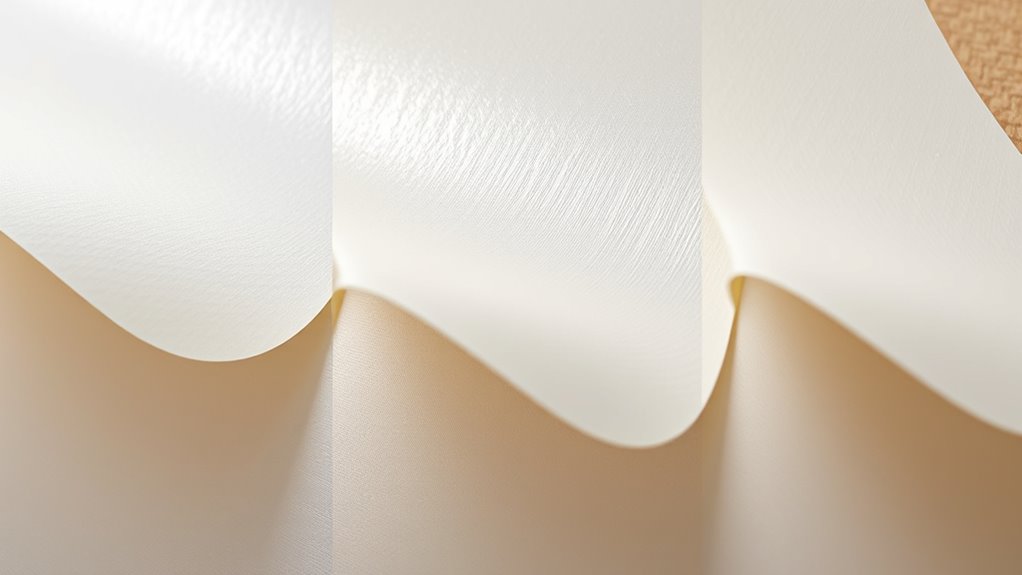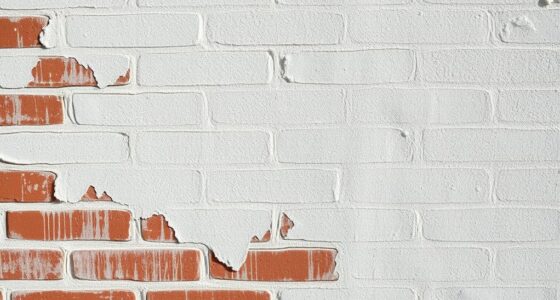Wallpaper adhesives come in three main types: pre-pasted, unpasted, and paste-the-wall. Pre-pasted wallpaper already has adhesive on its backing and only needs water activation, making installation quick and clean. Unpasted wallpaper requires you to apply adhesive to each strip, offering more flexibility and easier removal—great for rentals. Paste-the-wall adhesive involves applying glue directly to the wall for strong, even bonding. If you’re curious about which works best for your project, you’ll find helpful details ahead.
Key Takeaways
- Pre-pasted wallpaper has adhesive already applied and is activated with water, ideal for quick, clean installations.
- Unpasted wallpaper requires manual adhesive application, offering easy removal and flexibility for temporary or rental decor.
- Paste-the-wall wallpaper involves applying adhesive directly to the wall, suitable for textured or vinyl wallpapers for strong, even bonding.
- Proper surface preparation and application techniques are essential for durability and a flawless finish across all adhesive types.
- Selection depends on project needs, with pre-pasted for convenience, unpasted for temporary use, and paste-the-wall for ease of removal and textured surfaces.
Understanding Pre‑Pasted Wallpaper
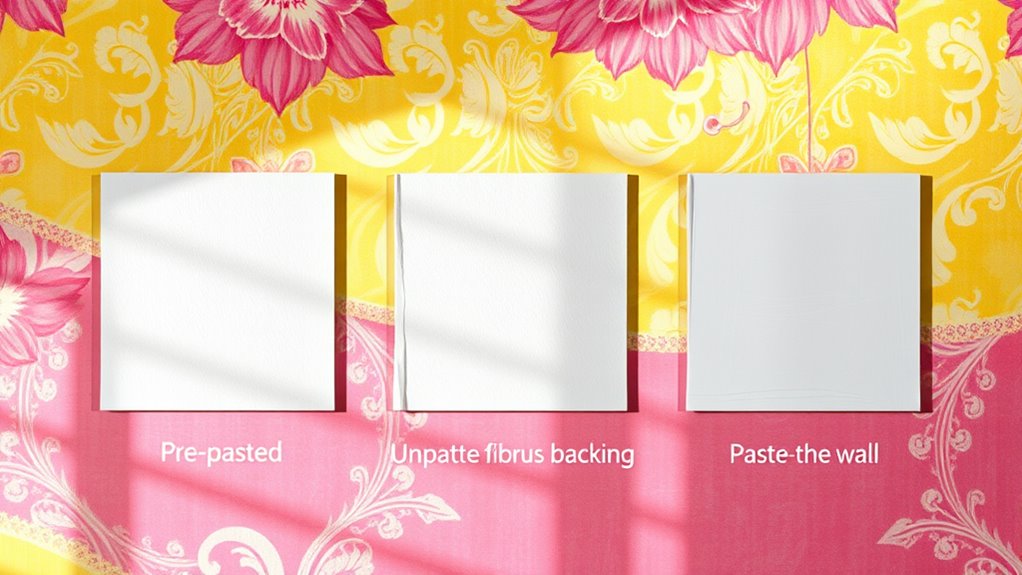
Pre-pasted wallpaper has become popular because it simplifies the wallpapering process. When choosing this type, you’ll notice a variety of wallpaper patterns designed to suit different styles, from bold designs to subtle textures. The adhesive is already applied to the backing, making installation easier—you just need to activate it with water. The key advantage of pre-pasted wallpaper is its reliable adhesive durability; it sticks well once activated, ensuring the wallpaper stays in place over time. Unlike unpasted options, there’s no need to handle separate glue, reducing mess and application time. This convenience makes pre-pasted wallpaper ideal for beginners and busy homeowners. Just follow the instructions, activate the adhesive properly, and enjoy a smooth, secure finish that lasts. Additionally, understanding how adhesive strength impacts the longevity of wallpaper can help you choose the best option for your space. Proper preparation and application techniques, including correct activation methods, contribute significantly to the overall durability, ensuring your wallpaper remains attractive for years. Being aware of application techniques can also prevent common mistakes that compromise the adhesion process.
How Unpasted Wallpaper Works
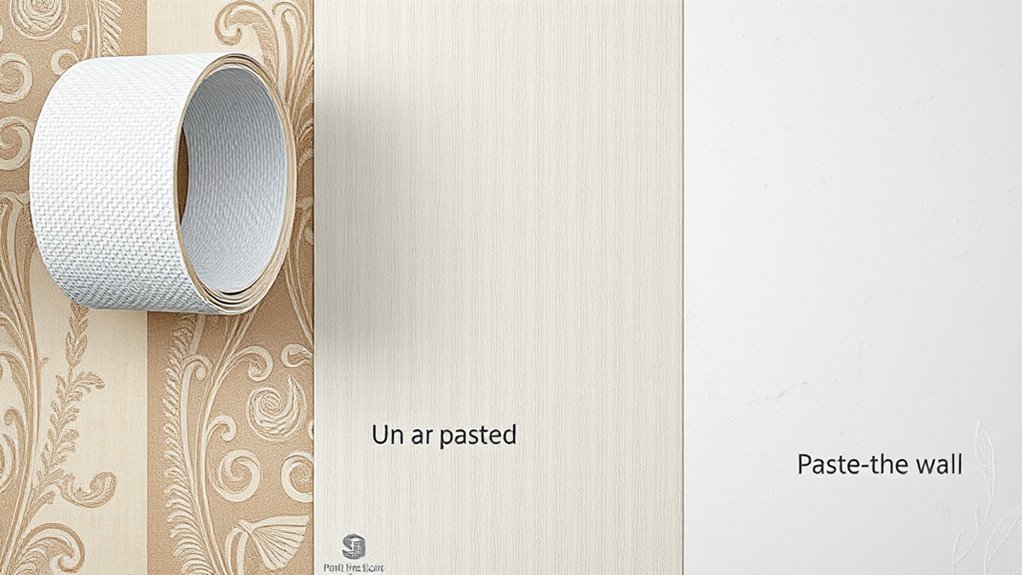
When you apply unpasted wallpaper, you spread adhesive directly onto the back of each strip, ensuring a strong bond. As it dries, the adhesive holds the paper securely in place, but you’ll need to monitor the drying process to prevent bubbles or wrinkles. When it’s time to remove the wallpaper, the adhesive’s loosened hold makes stripping easier, especially if you rewet the surface. Proper preparation, such as cleaning the wall surface, can also help maintain the integrity of the wallpaper adhesion over time.
Applying the Adhesive
To apply unpasted wallpaper, start by spreading the adhesive evenly on the back of each strip using a brush or roller. Pay attention to texture variation, assuring the adhesive covers all areas uniformly to prevent bubbles or wrinkles. As you work, keep in mind that good adhesion aids in achieving seamless color matching between strips, making the final appearance more professional. Apply the adhesive with enough pressure to fill in textured surfaces, especially if your wallpaper has a distinct pattern or rough finish. Be careful not to overload the paper, which can cause excess mess and difficulty lining up your strips. Proper application of the adhesive ensures a smooth, even surface and helps your wallpaper stay securely in place. Additionally, selecting the right type of adhesive suitable for your wallpaper material can enhance the overall durability and ease of installation adhesive compatibility. Using the correct adhesive performance kits can also simplify the process and improve the longevity of your wallpaper. For added durability, choosing a name that reflects strength or resilience can be beneficial, similar to selecting a dog name that symbolizes robustness. Being aware of regional regulations about wallpaper installation can also ensure compliance with safety standards and best practices.
Drying and Removal Process
Ever wonder how unpasted wallpaper dries and comes off when you’re ready to remove it? Once applied, the adhesive’s durability determines how well it sticks and how easily it comes off later. Typically, unpasted wallpaper dries as the moisture evaporates, forming a flexible bond. When removal time arrives, different techniques apply based on the adhesive’s strength and wall condition. Use hot water, scoring tools, or commercial removers to loosen the paper. The table below highlights key removal strategies:
| Technique | Best Use Case | Effectiveness |
|---|---|---|
| Hot Water | Light adhesives | High |
| Scoring Tools | Stubborn areas | Moderate |
| Commercial Removers | Heavy-duty adhesives | Very effective |
| Steaming | Delicate wallpapers | Gentle but effective |
| Peel & Stick | Easily removable wallpapers | High |
Proper removal guarantees minimal wall damage, especially with durable adhesives.
The Paste‑the‑Wall Method Explained
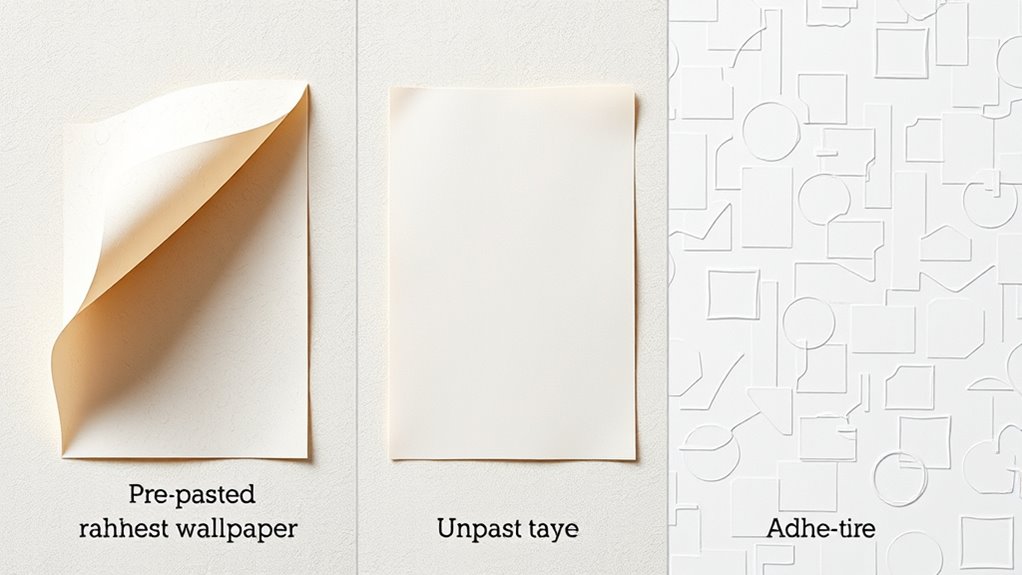
The paste‑the‑wall method simplifies wallpaper application by applying adhesive directly to the wall instead of the paper. This technique reduces mess and speeds up the process, making it ideal for large areas. When you use this method, ensure you spread the adhesive evenly on the wall to promote better wallpaper durability. Proper application helps prevent bubbles and wrinkles, maintaining a smooth finish. Keep in mind that the adhesive needs adequate time to dry before hanging the wallpaper to ensure strong adhesion. Rushing this step can compromise the wall’s surface and the wallpaper’s overall durability. This method is especially effective with modern, peelable wallpapers, which benefit from a strong, well‑bonded installation. Overall, the paste‑the‑wall approach offers a straightforward, efficient way to achieve a lasting, professional look.
Comparing Adhesive Types: Pros and Cons
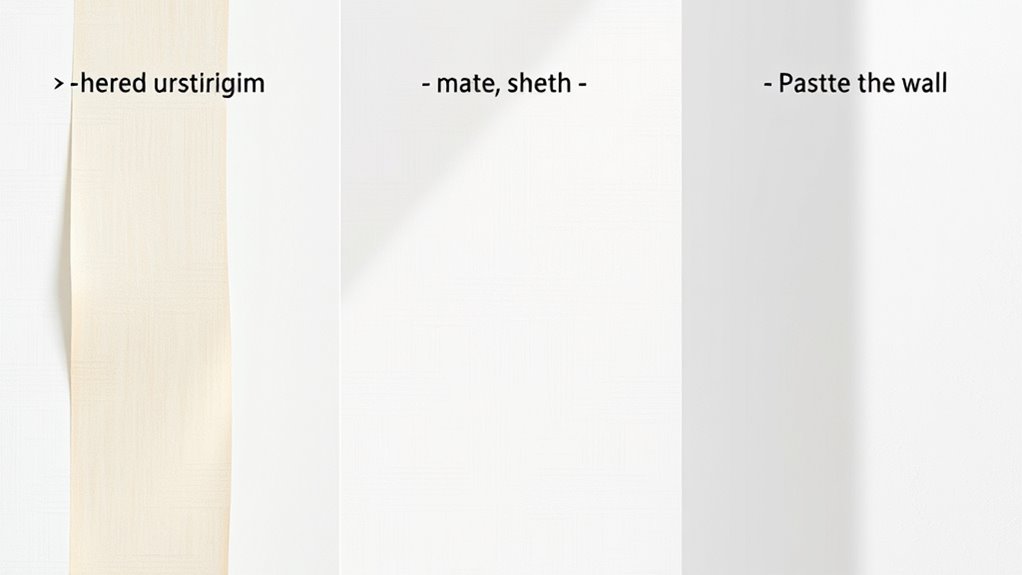
Choosing the right adhesive depends on your wallpaper type and project requirements, as each adhesive offers distinct advantages and drawbacks. For example, pre‑pasted adhesives are convenient and easy to use, but may have limited adhesive strength, making them less suitable for heavy or textured wallpapers. Unpasted adhesives often provide stronger bonding, which is beneficial for long-lasting results, but their longer drying time requires more careful application. Paste‑the‑wall adhesives strike a balance with quick drying times and good adhesive strength, making them versatile for various wallpaper types. Consider how quickly you need the wallpaper to set and how much holding power you require. Weighing these factors helps ensure you select an adhesive that delivers the desired durability and ease of installation. Additionally, choosing an adhesive with proper ventilation and safety features is important for maintaining indoor air quality during application, especially as proper ventilation can also support health and safety during projects. Being aware of the water chemistry involved in adhesives can also help prevent issues like mold or improper bonding over time. For instance, understanding how spoiled lemon juice can develop mold or off-flavors highlights the importance of proper storage and application of adhesives to avoid similar problems like mold growth or ineffective bonding.
Best Applications for Pre‑Pasted Wallpapers
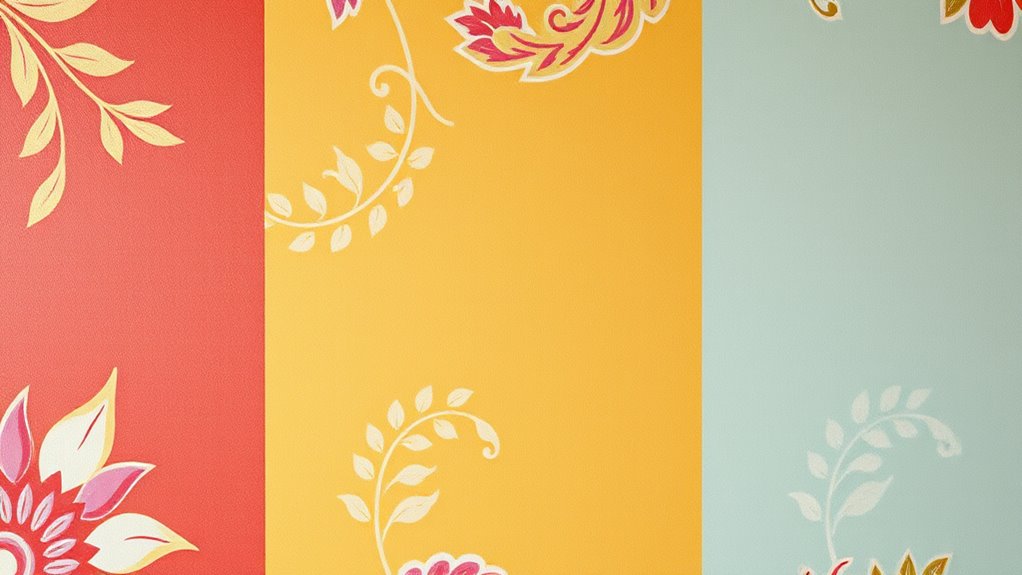
Pre-pasted wallpapers are ideal for projects where quick and straightforward installation is a priority. They work well with a variety of wallpaper patterns, from simple designs to intricate motifs. Since the adhesive ingredients are pre-applied, you simply activate the paste by soaking the wallpaper in water, reducing preparation time. This makes them perfect for DIY enthusiasts or when you need to cover large areas efficiently. Pre-pasted options also minimize mess, as there’s no need to handle separate adhesives. They’re especially suitable for smooth, clean surfaces like painted or wallpapered walls, where the adhesive can bond effectively. Overall, pre-pasted wallpapers are best for those seeking a hassle-free, clean, and speedy wallpapering process with consistent adhesion.
Ideal Uses for Unpasted Options
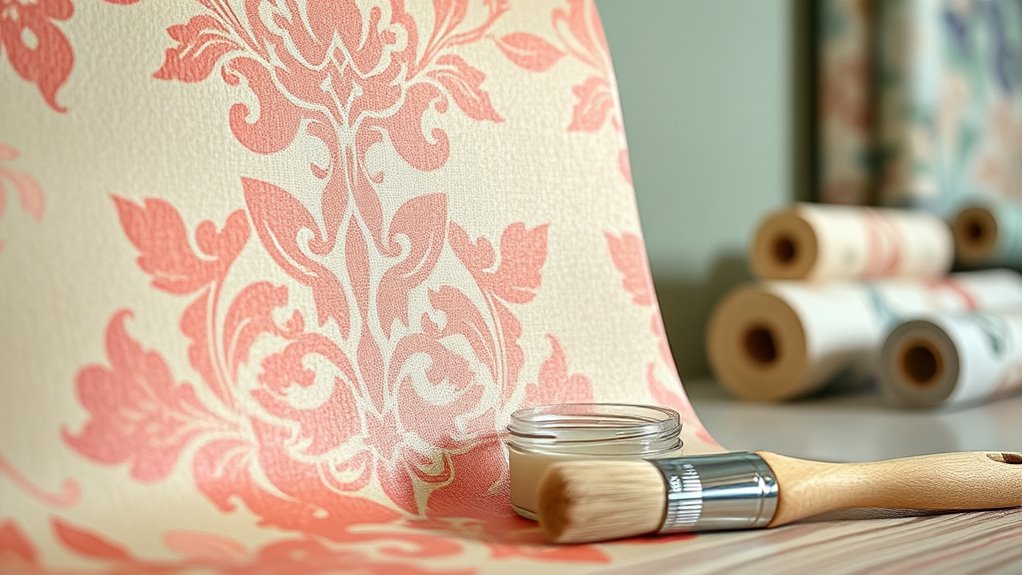
Unpasted wallpaper is great for temporary wall decorations or if you’re renting and want to avoid damage. It’s also ideal when you need a quick, clean removal process without leaving residue. These options give you flexibility and ease for short-term or rental projects. Additionally, unpasted wallpaper allows for easier seasonal cleaning and adjustments as needed. Because they typically require only water or a mild solution for installation, they are user-friendly and suitable for DIY enthusiasts. Moreover, their removal process is straightforward, making them a popular choice for those who frequently change their decor.
Temporary Wall Decorations
Temporary wall decorations are a great way to quickly and easily refresh a space without committing to permanent changes. Unpasted wallpaper is ideal for these projects because it’s easy to install and remove without damaging your walls. When you decide to change the decor, wallpaper removal is simple, leaving minimal residue and mess. Plus, since unpasted adhesives are lightweight, you can store leftover adhesive in a sealed container for future use or quick touch-ups. This flexibility makes unpasted options perfect for seasonal displays, event decorations, or experimenting with patterns without long-term commitment. Whether you want a fresh look for a special occasion or to update a room temporarily, unpasted wallpaper offers an easy, non-permanent solution that saves you time and effort. Additionally, the ease of removal reduces the risk of damage, which is especially important when considering AI security measures that protect digital content and physical assets from accidental harm. Using removable adhesives can also help prevent wall damage, making these options even more suitable for temporary applications. Incorporating safe materials in wallpaper adhesives further ensures that your walls remain undamaged and the environment stays protected during removal. Moreover, choosing adhesives designed for synthetic materials can improve the overall results and ease of application.
Rental Property Applications
Are you looking for a practical way to update your rental property without risking damage or losing your deposit? Unpasted wallpaper options are perfect for this. They allow you to experiment with different wallpaper textures and wall colors without permanent commitment. You can add visual interest or warmth to a room easily, then remove it when needed.
Here’s how unpasted wallpaper fits your needs:
| Advantages | Ideal For | Emotional Impact | Considerations |
|---|---|---|---|
| Easy to remove | Temporary updates | Refresh your space effortlessly | Avoid damage to walls |
| Budget-friendly | Frequent changes | Feel empowered to change decor | Suitable for rental restrictions |
| Wide variety | Personalization | Express your style freely | Keep in mind application tips |
| No damage risk | Short-term projects | Enjoy a fresh look anytime | Use appropriate adhesive techniques |
| Flexible for temporary renovations | Quick room makeovers | Feel confident in decorating choices | Ensure proper removal methods |
Easy Removal Process
Removing wallpaper easily is one of the biggest advantages for renters and DIY enthusiasts alike. Unpasted wallpaper simplifies adhesive removal, making the entire wallpaper disposal process much faster and less messy. Since unpasted options don’t have a glue backing, you can dampen the wallpaper with water or a mild removal solution, which loosens the adhesive without damaging your walls. This ease of removal means less scrubbing and fewer tools needed, saving you time and effort. It’s especially ideal if you plan to update or change your decor frequently. Plus, the straightforward removal process helps prevent wall damage, making future repainting or wallpapering simpler. Additionally, understanding the importance of creative storytelling can help you design a space that reflects your personality and enhances your home environment. Choosing the right type of wallpaper can also contribute to easier wall maintenance and ongoing upkeep.
When to Choose Paste‑the‑Wall Adhesive
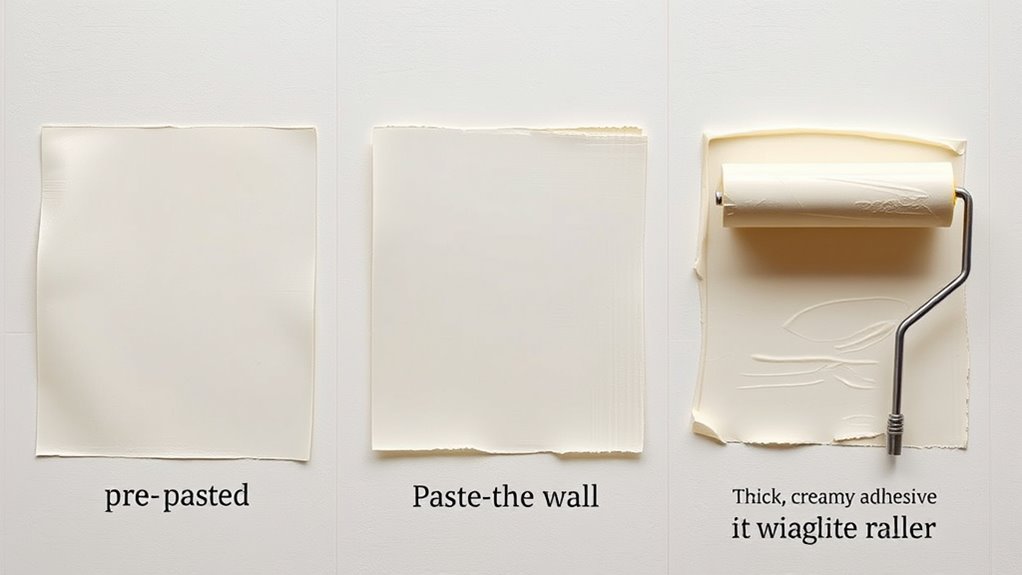
You should consider using paste-the-wall adhesive when you’re working with lightweight or delicate wallpapers that require a smooth, even application. This type of adhesive is ideal because it allows you to apply the paste directly to the wall, making the process easier and reducing mess. Choose paste-the-wall adhesive if:
- You plan to do frequent wallpaper removal, since it’s easier to strip without damaging the wall.
- You want to optimize adhesive storage, as it stays workable longer and minimizes waste.
- You’re working with textured or vinyl wallpapers that need a strong, consistent bond.
- It is especially suitable for ethical hacking practices, where controlled and efficient methods are essential for testing security measures.
This adhesive is perfect for those who want a clean, efficient installation. It also simplifies future removal, saving you time and effort.
Preparing Your Surface for Wallpaper
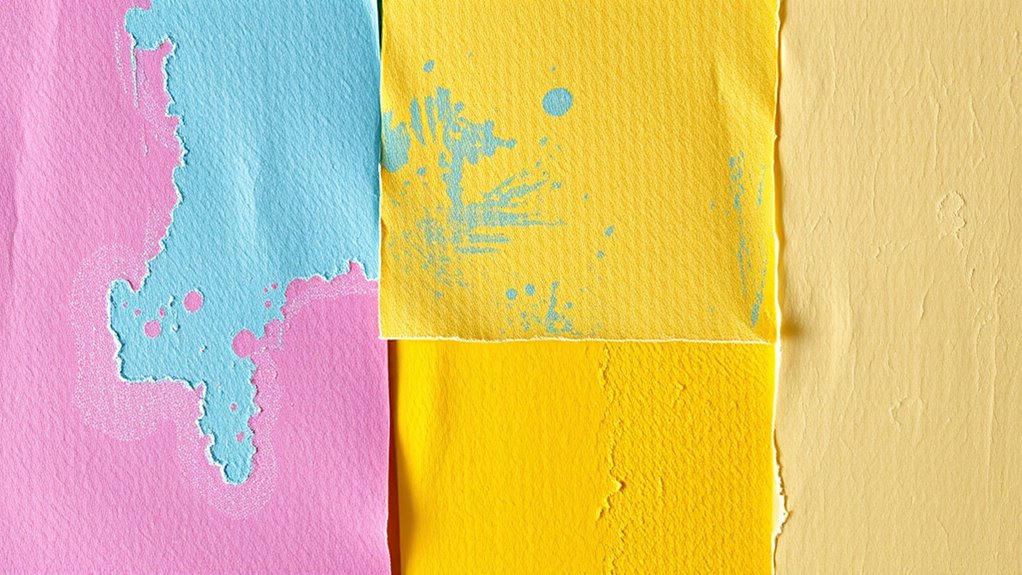
Before applying wallpaper, it’s essential to prepare the surface properly to guarantee a smooth, long-lasting finish. Start by cleaning the wall to remove dust, grease, or old wallpaper residue that could affect adhesion. Check for uneven spots or holes and repair them with spackle or filler, then sand smooth. If your wallpaper has bold patterns, ensure the surface is uniform to prevent misaligned designs. Consider your adhesive storage; use fresh adhesive suited for your wallpaper type to avoid issues like bubbling or peeling. A clean, smooth surface helps the wallpaper patterns align correctly and ensures the adhesive bonds securely. Proper preparation minimizes future problems, giving you a professional-looking result that lasts.
Applying Different Types of Wallpaper Adhesives
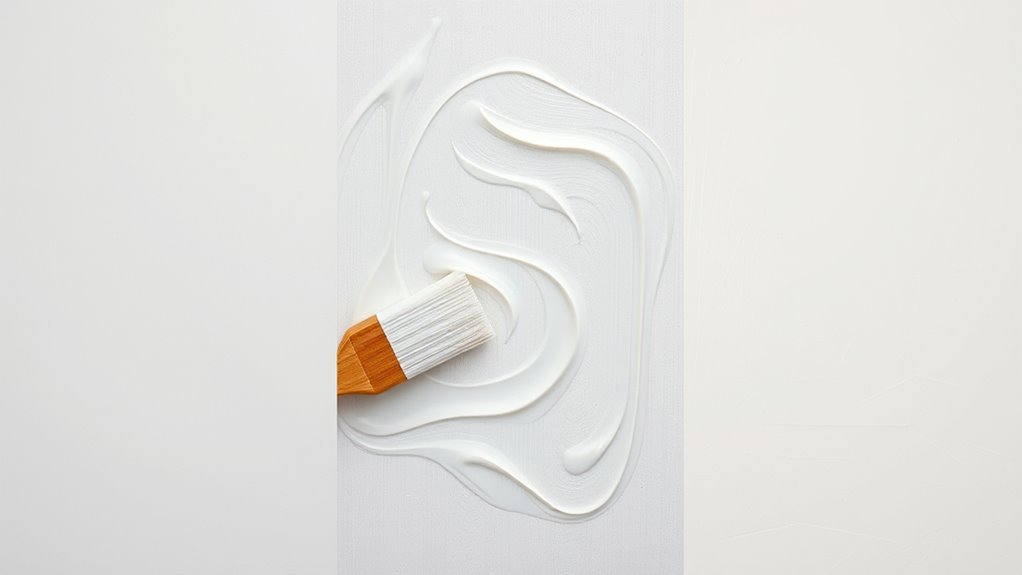
Choosing the right wallpaper adhesive depends on the type of wallpaper you’re installing. Different wallpaper patterns and adhesive history influence your choice. Here are three key steps:
Selecting the correct wallpaper adhesive ensures a smooth, secure finish tailored to your wallpaper type and pattern.
- Select the adhesive type based on your wallpaper—pre‑pasted, unpasted, or paste-the-wall—each requiring a specific application process.
- Apply the adhesive evenly using a roller or brush, ensuring coverage matches the wallpaper’s pattern and weight.
- Follow manufacturer instructions for drying times and proper application techniques, which vary depending on the adhesive’s formulation and your wallpaper’s pattern complexity.
Understanding the adhesive history helps you appreciate how these products evolved, offering better adhesion and easier application. Proper application ensures your wallpaper stays smooth and secure, no matter the pattern or adhesive type.
Tips for Achieving a Professional Finish
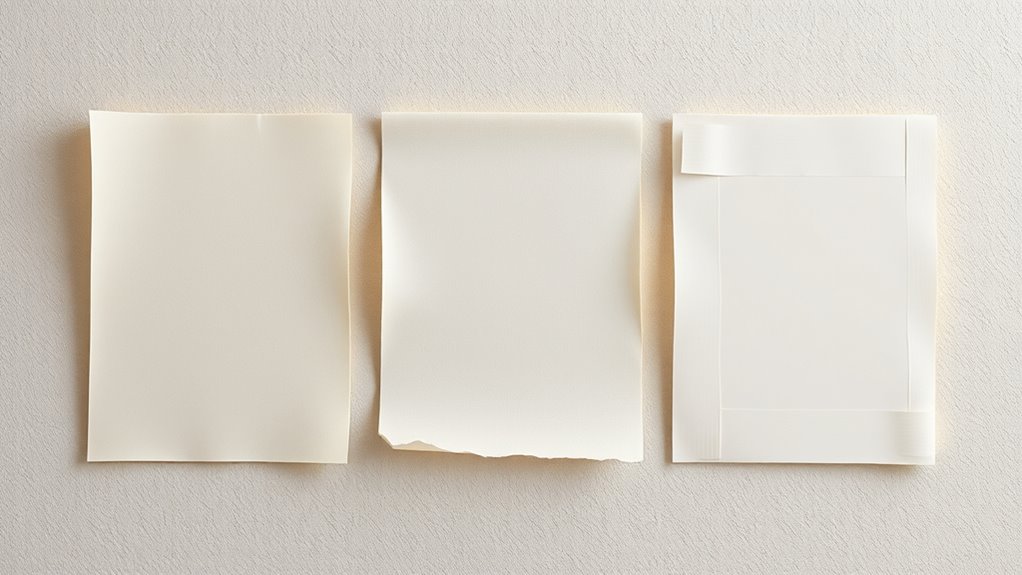
To get a professional finish, start with a clean, smooth surface free of dust and grease. Make sure you apply the adhesive evenly and follow the manufacturer’s instructions carefully. Using precise hanging techniques will help guarantee your wallpaper looks flawless and lasts longer.
Proper Surface Preparation
Achieving a professional finish with wallpaper hinges on proper surface preparation, which guarantees the adhesive bonds well and the final appearance is smooth. First, ensure your wall surface texture is even by sanding rough spots and filling holes; this creates a uniform base. Second, remove any peeling paint and check for paint compatibility to prevent future issues; use a primer if necessary. Third, clean the wall thoroughly to eliminate dust, grease, or dirt that could interfere with adhesion. By addressing these key areas, you’ll create an ideal surface that promotes strong adhesion and a flawless look. Remember, a well-prepared wall is the foundation for beautiful, long-lasting wallpaper.
Correct Adhesive Application
Have you ever wondered how to guarantee your wallpaper sticks perfectly and looks flawless? Proper adhesive application is key. First, ensure your adhesive is stored correctly in a cool, dry place to prevent spoilage. Using the right wallpaper tools, like a notched trowel or roller, helps spread the adhesive evenly. An uneven coat can cause bubbles or peeling. Always follow the manufacturer’s instructions for mixing and applying. Before starting, prepare your workspace and gather all necessary tools. Here’s a quick visual:
| Wallpaper Tools | Purpose |
|---|---|
| Notched Trowel | Evenly spreads adhesive |
| Roller | Removes air bubbles |
| Brush | Edges and corners |
| Adhesive Storage | Keeps adhesive fresh |
| Level | Ensures straight lines |
Proper application ensures a smooth, professional finish.
Precise Hanging Techniques
For a truly professional wallpaper finish, paying close attention to hanging techniques makes all the difference. Ensuring your wallpaper pattern aligns perfectly and that adhesive longevity is maximized requires precision. Here are three key tips:
- Carefully align each strip, matching the wallpaper pattern seamlessly to avoid uneven lines or gaps.
- Use a smoothing tool to press out air bubbles and excess adhesive, which helps maintain a flat surface and prevents peeling.
- Trim excess wallpaper at edges and seams for a clean, polished look, securing the longevity of the adhesive and preventing future peeling.
Frequently Asked Questions
Can Wallpaper Adhesives Be Reused for Multiple Projects?
You can’t reuse wallpaper adhesives for multiple projects because most aren’t designed for reuse. Reusable adhesives are rare and often require special storage or adhesive preservation methods to maintain their effectiveness. If you try to reuse leftover adhesive, it may lose its stickiness or cause bubbles and wrinkles. It’s best to buy fresh adhesive for each project to guarantee proper adhesion and a smooth finish.
How Long Does Each Adhesive Type Typically Last After Application?
Imagine your wallpaper’s adhesive longevity is like a vintage vinyl record—lasting years if properly applied. Generally, pre-pasted adhesives last around 7-10 years, unpasted about 5-7 years, and paste-the-wall adhesives up to 10-15 years. Durability timelines depend on factors like humidity and surface prep. For best results, follow manufacturer instructions and keep an eye on how well your wallpaper adheres over time to guarantee lasting beauty.
Are There Eco-Friendly or Low-Voc Wallpaper Adhesive Options?
Yes, you can find eco-friendly adhesives and low VOC options for wallpaper. Look for products labeled as environmentally safe, which use natural ingredients or low-impact chemicals. These adhesives reduce harmful emissions and are better for your health and the environment. When choosing, check product labels and specifications to guarantee they meet eco-friendly standards, and consider brands committed to sustainable practices for a safer, greener wall covering project.
What Are Common Mistakes to Avoid When Applying Paste-The-Wall Adhesive?
Ever wonder how to avoid common mistakes when applying paste-the-wall adhesive? First, verify proper wallpaper prep by cleaning and smoothing your walls. Don’t forget to use the right adhesive tools, like a roller or brush, for even coverage. Avoid applying too much adhesive, which can cause bubbling or slipping. Always follow the manufacturer’s instructions closely, and double-check your measurements—this keeps your wallpaper looking flawless and helps you avoid unnecessary rework.
How Do I Remove Wallpaper With Different Adhesive Types Easily?
To remove wallpaper with different adhesive types easily, start by testing a small area. For paste-the-wall adhesive, use detergent solutions to loosen the glue, then gently scrape. For stubborn spots, steam removal helps soften the adhesive. Make sure to work slowly to avoid damaging the wall. Repeating these steps guarantees you effectively remove various adhesives, making your wall ready for new wallpaper or paint.
Conclusion
Just as Da Vinci meticulously prepared his canvas, selecting the right wallpaper adhesive sets the stage for a masterpiece. Whether you opt for pre-pasted, unpasted, or paste-the-wall, understanding each method guarantees a flawless finish. With patience and attention to detail, you’ll transform your space into a work of art—proof that, like the greatest artists, your craft lies in the careful choice and application of every element.
